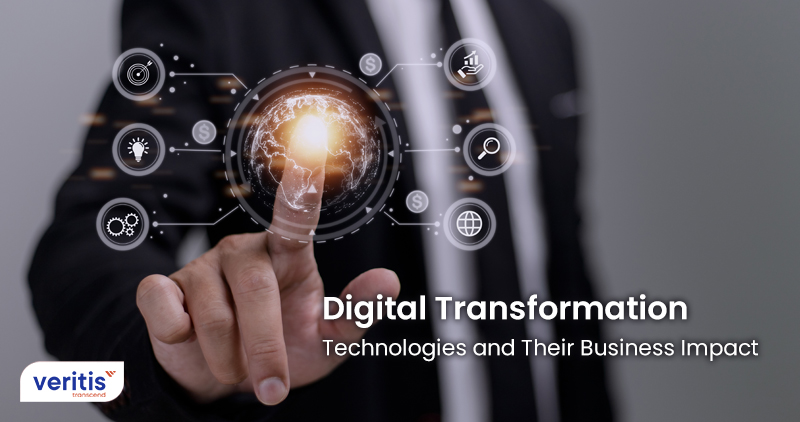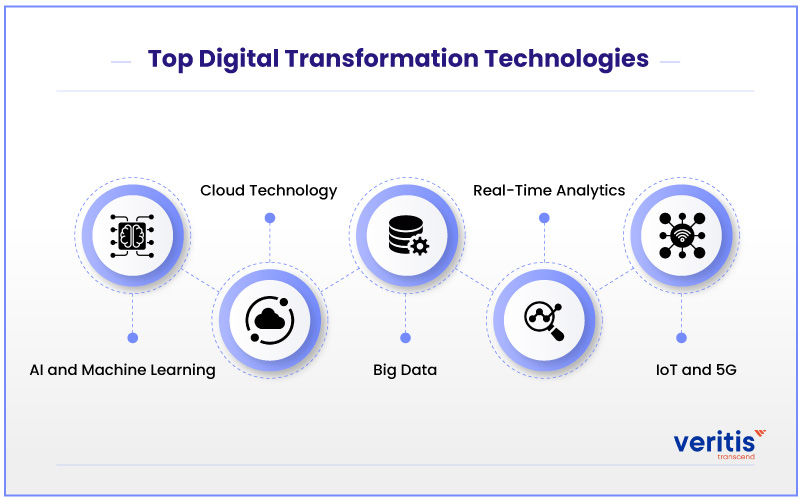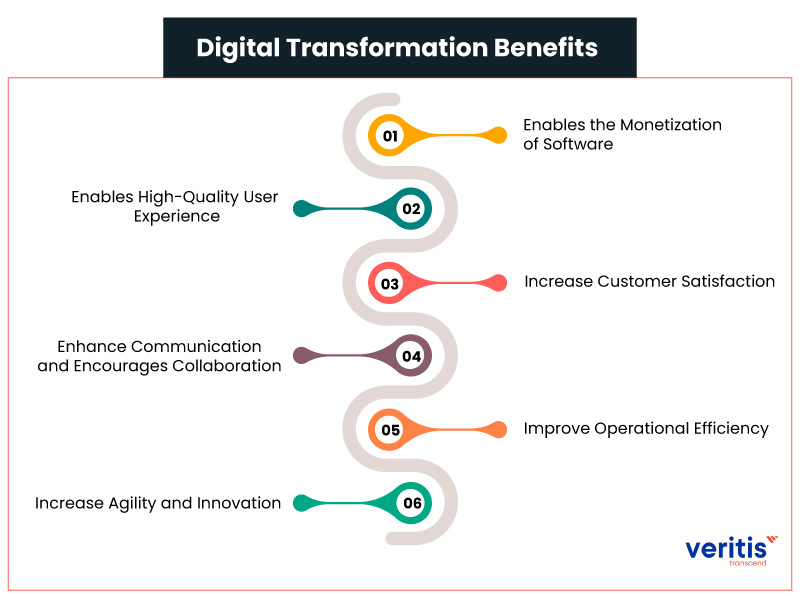
Table of contents
Digital transformation is changing a company’s operations to make them more effective using digital technologies. The goal is to use technology to augment a current service rather than simply re-creating it in a digital format. Companies that successfully adopt digital transformation expand more quickly than their competitors. However, depending on certain company features, this method will seem different in each unique situation.
Technology is one aspect of the digital transformation framework. Changes in company culture and business operations are equally important to the organization’s success. Large, successful companies that are going digital transformation may compete with more agile and digital-only competitors. At the same time, smaller firms can adjust their product offerings to changing market conditions.
This further proves that firms have the incorrect assumption that all technologies apply to all types of enterprises. Instead, the adoption of new technologies mostly depends on the requirements of an organization, its customer base, and market trends.
“According to Statista, spending on digital transformation technology and services is expected to exceed USD 1.8 trillion in 2022 and reach USD 2.8 trillion by 2025. This expansion reveals how much money companies want to spend on capital to remain competitive. According to Markets and Markets, global spending on digital technologies is predicted to reach USD 1247.5 billion by 2026.”
The amount of money expended by digital transformation service providers for firms has increased dramatically. Organizations have switched to new business models to improve flexibility, scalability, and cost management. All services, such as supply chain management, online purchasing, and remote learning, are going digital.
No particular technology is at the center of the digital transition. Any technological advancement that helps a company to grow and produce better results might be included. A company’s understanding of digital transformation (DT) principles and methodologies should be clear before they embark on its digital transformation. Only then, the corporate transformation performance will have a favorable effect.
This blog will explore the details of digital transformation, types of digital transformation, technologies, strategies, and benefits. So, let’s have a look at it.
Digitally Transform Your Business
What is Digital Transformation?
Digital transformation fundamentally changes how a business function, communicates, and interacts with customers. The shift toward more digital operations disrupts the “conventional” manner of doing things. Therefore, promoting a digital culture within your firm and upskilling your workforce is essential. Because process transformations require a team effort. It’s a cultural shift that involves constant experimentation and comfort with failure on the part of organizations.
The road to digital transformation services can take many different directions, and each organization’s journey will be different. For instance, a business might use cloud computing or AI to improve the client experience. It might also revamp its supply chain to better use machine learning insights. Even then, business transformation services can accurately estimate and meet the goods consumers desire in a few months.
Differences Between Digitization, Digitalization, and Digital Transformation?

When discussing businesses and technology, there are many terms that might easily be misunderstood. Digitalization, digitization, and digital transformation framework are the most often used ones. To see the differences, let’s examine each of them.
1) Digitization
Making anything digital or producing it in a digital format is referred to as digitization. For instance, if you publish a printed newsletter or magazine online. Or else if you sign papers online using an electronic signature.
2) Digitalization
Digitalization is using technology to alter your business model or create a new source of income. The goal is to establish digital business transformation services using online technology and channels. Instances such as automation speed up workflows or cloud computing to store data.
3) Digital Transformation
Digital transformation is a reinvention process. It examines how to use digital technology and procedures to create new systems, develop a digital mindset, and take advantage of untapped opportunities.
Useful link: 10 Factors That Can Drive Your ‘Digital Transformation’ Initiatives!
Digital Transformation Types
Although many firms concentrate on organizational change, there are four forms of digital transformation companies to go through if you want to get the most out of it. These consist of the following:
1) Business Model Transformation
Business model transformation is all about making basic adjustments to a company’s operations, such as employees, operational methods, and tools. Consider Netflix, the industry titan that entirely flipped the traditional video distribution business model to disrupt it.
2) Process Transformation
This focuses on your internal systems, such as data, analytics, AI, and other systems that can help the company cut costs and improve operational effectiveness. For instance, with its recent Walgreens app revamp to serve better customers and centralize its digital assets. Healthcare retail giant Walgreens serves as an excellent illustration of this.
3) Organizational Transformation
Mindsets, procedures, capabilities, and skills need to redefine for a digital world. It improves advancing digital business transformation services through expansion projects that are founded in a new culture and style of thinking. Pitney Bowes is a fantastic example of this because it changed from providing mailing solutions to providing shipping and e-commerce technology before becoming a digital corporation.
4) Domain Transformation
This region presents a great opportunity to acquire new tools and enter a new industry. For instance, consider Google and the several commercial ventures it has launched, including Google Nest, an Internet of Things (IoT) product that provides thermostats and smoke detectors for the house.
Top Digital Transformation Technologies

Solutions for digital transformation using emerging technologies are picked based on an analysis of customer behavior, preferences, and unique internal business procedures. What technologies enable digital transformation are listed below. Let’s go through it.
1) Artificial Intelligence and Machine Learning
The goal of machine learning (ML) and artificial intelligence (AI) is to simulate human cognitive operations. AI is used in speech recognition, natural language processing, computer vision, expert systems, and predictive analytics.
Initiatives for digital transformation companies heavily depend on AI/ML as part of new business strategies. These tools are essential for enhancing productivity as well as for making better use of the data that companies gather. Businesses may build creative ideas and better products and services by gaining actionable insights from data on digital transformation trends.
2) Cloud Technology
Cloud tools could significantly change existing business models. Using them enables the flexible usage of remote resources for on-demand data processing and storage. And that significantly lowers the cost of the infrastructure and hardware. With the help of this technology, teams may operate online more effectively and store massive volumes of data. While still preserving the highest level of security.
The financial gain for firms is another significant benefit of using cloud tools. After all, the first few years after the purchase are when in-house hardware purchases are more profitable in digital transformation tools.
3) Big Data
Data is a crucial resource for most enterprises and is referred to as the “fuel” of the modern economy. This has resulted in exponential expansion, both a challenge and an opportunity for any firm. This growth anticipates continuing in the upcoming years.
Big data can consist of structured, semi-structured, and unstructured information gathered by firms from their clients, during routine business activities, or from outside sources. Predictive modeling, data mining, and other data analytics techniques can all be applied to this data.
4) Real-Time Analytics
Analyzing related resources and data as soon as they enter a system is known as real-time analytics. Real-time computing refers to the capacity to respond to data in a manner that users perceive as quick.
Real-time data delivery from operational systems is made possible by streaming data architectures. Which also make use of powerful analytics engines and enable quick operational decisions. Robotic process automation (RPA) and other types of automated policy enforcement can execute these choices in digital transformation trends.
5) IoT and 5G
The Internet of Things (IoT) is a combination of computers, machines, and other items linked to the Internet. And it has the capability to send and receive data through a network. They frequently can operate without supervision from a person or traditional computer system in digital transformation tools.
IoT devices need more capacity, higher transmission speeds, and seamless communications, which 5G technology enables. For instance, as part of their digital transformation trends, most of the world’s big cities have established an IoT sensor network, with many of them linked by 5G.
The digital revolution in the manufacturing area is being driven by the Industrial Internet of Things (IIoT), often known as Industry 4.0. With this technology, firms may enhance workflows and boost flexibility, innovation, speed, and quality.
Useful link: 9 Key Digital Transformation Trends ‘To Watch’ in 2020 and Further
How to Adopt a Successful Digital Transformation Strategy?
A strategy for digital transformation cloud is a course of action for starting and advancing a digital transformation in the future for the industry. What business aims and objectives you hope to perform through digital transformation challenges will be specified in your strategy.
Here are a few steps to think about when executing a digital transformation platform strategy:
1) Establish New Business Processes
Your “business as usual” plan might not align with your digital IT transformation plan. Your firm will only succeed if you develop and implement new processes.
A digital transformation plan may necessitate some firms’ thorough revamp of operations. To effectively manage this change, all parties, such as employees and other stakeholders, must be ensured. You should be aware of the updates, who is responsible for what, and what mechanisms are being used to support them.
2) Determine Your Aims and Objectives
Your objectives should be laid out in a digital transformation strategy, along with the steps required to meet them. Every firm experience digital IT transformation in a different way. Thus, it’s crucial to remember that every organization has different goals. But there are several fundamental goals that each business should consider:
- How can you boost client engagement?
- With the implementation of new tools and methods, is it possible to develop a more economical and practical company model?
- Do you have methods in place for gathering information and data from analytics?
By providing answers to these questions, you may decide which elements of your strategy should be addressed first and which parts of your plan need immediate attention.
3) Get Employees and Leaders on Board
You need people’s support if you want your digital transformation plan to be successful. Obtaining executive sponsorship for your activities is the first stage. It is simple to start the planning process for digital transformation when there is executive support. In addition, having the C-suite on board helps hasten your digital transformation market.
Pay attention to the issues raised by your team members and employees. They will be more ready to participate in your transformation process if you can use digital transformation companies to address their challenges. Ensure that your staff members know the enterprise digital transformation platform and how it affects your business. Additionally, you can arrange conferences with significant parties to review the DX procedure and identify any problems before you start.
4) Create KPIs
The next stage is to create KPIs to monitor goals and measure success. Start with goals that are important to your team. For instance, IT teams can start keeping track of KPIs for a specific kind of infrastructure. Monitoring business activity trends and volumes might be the first step for service delivery and assurance teams. KPIs provide you with a target to work toward and will help assess your efforts’ effectiveness.
To evaluate the success of your KPIs, you can also include the best-case scenario, the worst-case scenario, and your anticipated outcome.
5) Pick Your Technologies Carefully
Make sure the technology you choose is compatible with the processes you are optimizing. Locate a technology that satisfies your requirements and aids in business expansion. In the end, the technology you choose should support your aims and be in line with your ambitions.
Useful link: Drive Customer Experience With Digital Transformation
Digital Transformation Benefits

The following are just a few advantages of digital transformation companies and their workforce:
1) Enables the Monetization of Software
When the annual Microsoft Convergence conference was taking place in 2015, Satya Nadella, the company’s CEO, turned to face the room’s leaders in business and industry and famously said: “Every company is a software company.” However, they didn’t understand software centricity well at the time.
All business leaders know that switching from a product-centric to a software-centric approach is essential. And that the best ROI for firms comes from software monetization. However, several firms fail to take off because they lack the knowledge to start software monetization engines.
2) Enables High-Quality User Experience
High-value firms are aware that they are providing experiences and products. Automaton, AI, and self-service tools are the foundation of digital transformation solutions. Which enables stunning, simple experiences. A smooth user experience will demonstrate that you have mastered the digital age.
3) Increase Customer Satisfaction
Expectations from customers have never been higher. On the one hand, clients desire tailored services that cater to their particular requirements. However, they don’t want to interact with people when it comes to things like accessing, updating, or deactivating and reactivating software since they want things to happen automatically. You will be able to use powerful digital tools and strategies, one of the most apparent benefits of digitization for business.
4) Enhance Communication and Encourages Collaboration
You need a digital platform that promotes communication and collaboration between all internal divisions. Suppose you want to increase innovation and output. Digital transformation solutions get rid of redundant processes, long response times, lost data, and inefficient idea sharing. Digitalizing your company’s internal communications will boost responsibility, creativity, and productivity. At the same time, you are giving the edge you need to exceed the competition.
5) Improve Operational Efficiency
Your working efficiency increases with digital transformation solutions. You can streamline cumbersome manual operations and cut costs by combining office systems, automating delivery methods, and updating your products. You can increase productivity and bridge income gaps using digital business process transformation. Since effective business practices are linked with digital business.
6) Increase Agility and Innovation
Agility in a company refers to the capacity to evolve swiftly and continually. Particularly, when it comes to digital operations. An agile organization is better able to manage uncertainty, establish responsibility, and accountability, reduce risk, and accomplish particular goals. This will assist you in building a successful and sustainable business.
Conclusion
Companies across all industries must adopt and adapt to digital to compete and flourish. However, navigating the digital shift to engage with customers and exert influence online can be challenging for many.
Implementation a single technology would not be sufficient to begin the digital transformation process. For all business operations, a technology-integrated approach is necessary. And not just within the company but also while dealing with its clients or partners.
Digitalization must eventually become a strategic cornerstone for every business and organization if they want to stay competitive and offer better services to their clients. Implementing digital transformation projects is wise if ease, scalability, and security are your main concerns.
Whether you need assistance along the way or wish to begin your enterprise digital transformation journey. Then, Veritis, the Stevie Award winner, will assist you in your efforts to implement digital transformation by guiding you through the process.
Got Questions? Schedule A Meeting
Additional Resources:
- Business Transformation Vs. Digital Transformation: A Thin Line of Difference!
- What are the critical components of Digital Transformation?
- Digital Transformation: IT-HR Collaboration Crucial for ‘Culture Change’
- 8 Factors That Drive Digital Transformation in Banking Industry
- Global Digital Transformation Market to Reach USD 1009.8 Billion by 2025
- How Digital Transformation Impacts IT Business in Real-time?